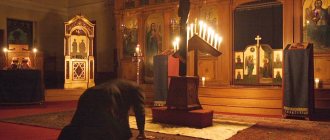What is the sign of the cross
The phrase “sign of the cross” means “sign of the cross.” This is the main Christian prayer gesture, which is a symbolic drawing of a cross with the right hand. You can make the sign of the cross over yourself, other people or inanimate objects. Why get baptized? To understand the meaning of this sacred gesture, it is necessary to understand the symbolism of the Christian cross.
Orthodox priest makes the sign of the cross
That is, a baptized person becomes a saint?
The conversation about holiness is long and not at all simple. Holiness is a property of God Himself, Who is completely unknowable, therefore what holiness is is not so easy to determine. One thing can be said with confidence: a person who has been baptized is called to holiness, but does not achieve it immediately and not always. Baptism does not deprive a person of free will and does not turn him into an incorporeal angel. He is also subject to various temptations and temptations, and he can also stumble and sin. It’s just that, unlike an unbaptized person, God’s gracious help is available to him to cope with all this. And, even if he stumbles and falls, he will be able to rise, repent and continue on his way.
“Baptized and anointed [with the Holy Spirit in the Sacrament of Confirmation. – Approx. ed.] has within himself, potentially, all the Divine gifts that are revealed in him at one time or another, depending on how much he purifies himself and becomes worthy of the action of the gifts of God in him,” wrote St. Simeon of Thessalonica (late XIV - XV century). So baptism is an absolutely necessary, although not the only condition for saving a person from sin.
Cross symbol
The cross is one of the most ancient and most important symbols of Christianity. It symbolizes the instrument of execution, the cross-shaped pillar on which the God-man Jesus Christ was crucified. By His voluntary death on the cross, He redeemed humanity from its sins and saved it from spiritual death, opening the way to the Kingdom of Heaven.
For Christians, the cross is a sacred reminder of the Lord's sacrifice, a sign of victory over evil and death. This is a symbol of the love of a merciful God for lost humanity and our weapon against dark forces. By honoring the cross, we honor Christ Himself. According to the Monk Joseph of Volotsky, any reverent image of this symbol is holy and gracious. Venerable Simeon the New Theologian teaches:
“Demons are afraid of the image of the cross and run away from it, knowing that the cross is a sign of man’s fellowship with God. Demons are apostates and enemies of God, removed from His Divine face. They no longer have freedom to approach those who have been reconciled to God and united with Him, and they can no longer tempt them” (“Words”).
We answer the question: why baptize a child? Different views!
Recently, more and more often, young parents have come to the conclusion that there is no need to baptize their child in infancy. Mostly, such thoughts come to those who have conceived a child without problems. If a child is conceived with God's help, then the parents baptize in infancy. You can find a prayer for the conception and birth of a healthy baby in the article “The correct lifestyle of a pregnant woman is the basis for the birth of a healthy baby.” Since everyone decides for himself to believe or not to believe in God, today’s child, growing up, will make a conscious decision on his own - to come to God or not. We have collected the most common answers to the question “Why baptize a child?” and we want to share them with you.
What does the church say?
Orthodox men who have dedicated their lives to serving God, when asked why, answer that Orthodox baptism of a child is a mandatory procedure, since everyone must be born “in the faith.” Through prayer and washing, original sin is removed from the newborn, and he joins the Church, becoming a son/daughter of God. After the ritual, a person with his worldly life can earn Eternal life. A baptized child is a lamb of God and for him in church you can ask before the Lord and light a candle.
What do grandmothers say?
For a long time, christenings were mainly held in villages in order to protect the child from the evil eye. Therefore, grandmothers always strongly recommend performing this ritual and only then showing the child “in public.” The older generation explains why baptism is quite simple - they baptize so that they don’t get sick, don’t cry, sleep well, and a lot of other similar reasons. They firmly believe in this, and indeed, miraculous recoveries of children after Orthodox baptism have been recorded more than once. In ancient Rus', the name under which the baby was baptized was carefully hidden, since it was believed that only by knowing this name could a person be damaged.
What do “worldly traditions” say?
No matter how sad it may sound, there are times when a child dies unbaptized. According to Holy Scripture, those who are not baptized are not seen in the Book of Life and the gates of Paradise are closed in front of them. Of course, in the modern world, where there are a lot of atheists and not particularly religious people, this is not considered an extraordinary event. But 20 years ago (a similar tradition still exists in villages), such children were not given funeral services and were buried outside the boundaries of the cemetery (the land in the cemetery is considered Orthodox) without a cross. Just imagine how poor parents, Orthodox people, go to the hump “in the field” and do not have the right to light a candle and read a prayer for their child.
How and why to be baptized?
The Orthodox sign of the cross is made with the right hand, connecting the tips of three fingers (thumb, index and middle). They symbolize the Holy Trinity. The remaining two fingers are close to the palm, signifying the dual nature of Christ, who is God and man.
If we sign the sign of the cross on ourselves, then we need to sequentially apply the brush in the position described above to the forehead, stomach, right and left shoulder. This symbolizes the sanctification of the mind, inner feelings and bodily powers. Also, the right side in the Christian tradition means salvation, and the left means destruction (Matthew 25:31-46). Thus, the movement of the hand from right to left symbolizes our prayer to God for the granting of the Kingdom of Heaven and deliverance from eternal torment.
If we baptize someone or something in front of us, then we need to move the brush from top to bottom, and then from left to right. You can be baptized with bows from the waist or to the ground, which express our humility before God. In the first case, this is bending the head to waist level, and in the second, kneeling with the head touching the floor. The sign of the cross and bows should not overlap each other. They are performed sequentially to avoid distortion of the depicted cross. All this must be done prayerfully, slowly and consciously. If we cross ourselves carelessly and thoughtlessly, we show disrespect for God and the Holy Cross.
So, by making the sign of the cross, an Orthodox Christian expresses faith in the God-Man Savior Jesus Christ and in the Holy Trinity. By placing the cross on ourselves, we ask God for help and grace, protection from visible and invisible evil, as well as salvation in Eternal Life. Archpriest Sergius Ksenofontov answers the question of why one needs to be baptized:
“The cross connects us to heaven. It commemorates the Sacrifice of Christ, made in the name of love for us. By making the sign of the cross, we testify that His sacrifice was made for us, and that He is the main thing in our lives. The bodily, physical movement in this case is the prayer of the body, the communion of the body as a component of our human being with this life in Him.”
Orthodox sacrament, what is its essence?
The following words are written in the Gospel of Mark: “Whoever believes and is baptized will be saved.” There is probably no need to explain the meaning of such a message. After all, it is clear that Orthodox baptism is a direct path to the salvation of the human soul.
The rite, called the “sacrament of baptism,” initiates spiritual rebirth for the Orthodox life, after living it worthily you will receive the Kingdom of Heaven as a reward. Why sacrament? But because through the ritual, God’s grace descends on the newborn in some way incomprehensible to us. With the name given during the sacrament, the child “receives” a guardian angel who protects him throughout life.
Even in Holy Scripture you can find that Christ, sending the apostles to preach to the people, taught them to baptize people.
When should you be baptized?
Authentic Christianity involves the desire to let God into every aspect of your life. Therefore, Orthodox Christians resort to the sign of the cross in a variety of circumstances. For a believer, this is a natural part of life, but at the same time it is not just a mechanical habit, but a reverent act of connection with God and serving Him. First of all, Christians are baptized during prayer, when venerating shrines (icons, the cross, the Gospel, the relics of the righteous, etc.), when entering and leaving the temple. Archpriest Andrei Efanov notes:
“We begin and end any prayer with the sign of the cross, be it an appeal to the Lord, the Mother of God, saints or angels.”
It is customary to be baptized at certain moments in the service. For example, when singing the Trisagion, Alleluia, the Creed, before and after reading the Gospel. We must not forget that the sign of the cross is a powerful tool for Christians in the fight against dark spirits and passions, as well as in other dangerous situations. Let us quote the words of Metropolitan Anthony (Pakanich):
“The sign of the cross is not just part of a religious ritual. First of all, it is an effective spiritual weapon. The Patericon, Patericon and Lives of the Saints contain many examples testifying to the spiritual power that the image of the Cross possesses.”
You need to be baptized outside of prayer with the words “In the name of the Father and the Son and the Holy Spirit, Amen.” In dangerous situations and sorrows, people are usually baptized with a short prayer, “Lord, have mercy!” In moments of joy and thanksgiving, it is customary to make the sign of the cross with the words “Glory to Thee, Our God, Glory to Thee!”
The sign of the cross is also accompanied by a blessing of a neighbor (for example, priestly or parental) or objects (meals, etc.) to invoke Divine grace on them. In this case, the priests use a special, nominal folding of the fingers, depicting the initials of Jesus Christ.
What is needed for the ceremony?
Of course, before baptizing a child, parents or godparents visit the church in advance and agree on the sacrament. The priest will definitely tell you about the necessary things, but there are attributes without which not a single baptism can be completed:
- A pectoral cross is a mandatory attribute. It doesn’t matter what it will be made of (gold, silver, wood), the main condition is the presence of a crucifix on it. Usually the cross is purchased and given by godparents. If it was not purchased in a church store, where all goods have already been consecrated, then it must be taken to the church in advance for consecration.
- Candles. They remain lit throughout the ceremony. It is better to buy them immediately at the church. After the sacrament is over, one of the relatives present must take all the candles home. They carry very strong energy and are lit at home while reading a prayer if a child is sick.
- Icon. It is also bought by godparents in the church where the child is baptized. Candles are lit in front of her during baptism and then taken home. It is advisable to hang this icon over the baby’s bed so that it protects the child.
- Bread. You can cook it yourself; the recipe is in the article “Yeast-free bread.” Bread must be present at the sacrament, since it symbolizes the flesh of Christ. Parents can prepare a baptismal shirt for the child, and godparents can prepare a kryzhma (a piece of fabric or a towel), in which the child is wrapped after the font.
Why to baptize a child, everyone decides for himself.
For deeply religious people, this is a mandatory ritual; for those who are less converted to Christ, this is their moral choice. Author of the publication: Evelina Belousova
History of the Sign of the Cross
Followers of Christ began to sign the sign of the cross back in the apostolic age. However, in those days people crossed themselves with only one finger. In this way, faith in one God was emphasized, since pagan polytheism was still widespread at that time. It is also known that the sign of the cross was originally applied only to the forehead, face or heart. Already in the 3rd century, this gesture was used in worship. The theologian Tertullian, who lived at that time, writes in his work “On the Warrior’s Crown”:
“At every entrance and exit, when we put on our shoes and dress, before bathing and eating, when lighting lamps, when going to sleep, when sitting down or getting down to any task, we make the sign of the cross on our foreheads.”
The whole body, as well as inanimate objects, began to be baptized around the 4th century. According to the poet of that time, Prudentius, Roman Christian soldiers made the sign of the cross before battles. His contemporary, Reverend Ephraim the Syrian, notes:
“Our houses, our doors, our lips, our breasts, all our members are overshadowed by the life-giving cross.”
In the 8th century, defending the dogma of the dual nature of the Savior against heretics, Christians began to increasingly cross themselves with two fingers. In this form, the gesture came to Rus', which adopted Christianity in 988. The familiar three-fingered sign of the cross as a sign of confession of the dogma of the Holy Trinity was finally established in the 13th century in Byzantium. In Rus', the new custom of the sign of the cross was introduced only in the middle of the 17th century. Believers (Old Believers) who did not accept this and other innovations of church reform are still baptized with two fingers to this day.
Superstitions about unbaptized children
Our ancestors believed that the fate of unbaptized children could be not only sad, but also terrible. They believed that such children are not “fully human”; they half belong to the other world from which they came to the world of the living. In Rus', the unbaptized, however, like the Gentiles, were called “Herods.”
It was forbidden to kiss an unbaptized child, take him outside the house, or show him to strangers. It was believed that such a child could be stolen by spirits - a brownie, a bannik, a goblin, replacing him with their own child, usually ugly and restless.
If a child died unbaptized, he, like a stillborn, fell into the category of “hostage dead.” Such children were buried separately, on the outskirts or behind the fence of the cemetery, or even simply buried under the floor, under the threshold of the house, in the garden or at crossroads. According to legend, the souls of unbaptized babies did not find peace and flew near their graves or rushed through the air in the form of whirlwinds or birds, especially before bad weather, screaming and demanding to be baptized.
Upon reaching the age of seven, the soul of such a child became the property of the devil and became an evil spirit. Common Slavic beliefs say that unbaptized children, after death, turn into various mythological creatures: vampires, mermaids, kikimoras. In Rus' there was a belief that an unbaptized child becomes an igosha - a domestic demon in the form of an armless and legless freak who plays pranks at night.
The spirits into which unbaptized children turned were considered dangerous to the living. So sometimes they appeared to their mothers, as a result of which they fell ill and died. In Rus' they believed that on Christmastide the souls of unbaptized children come out of hell, enter houses whose owners do not baptize the doors, and take with them everything they want.
So leaving a child unbaptized was fraught with huge problems. If this did happen, then it was necessary to arrange a ritual of remembrance: this was done on Semik - on Thursday in the seventh week after Easter or on Trinity week.
A mother whose child died before baptism had to buy 12 crosses and distribute them to other people's children - then, according to legend, 12 children's souls would be saved through the prayers of the apostles. On the eve of Trinity, eggs were painted red and yellow and distributed to neighboring children, and they were also treated to various foods - in honor of unbaptized souls.
They also brought comb honey to crossroads. According to legend, at night the souls of unbaptized children were supposed to come there for honey, and then their footprints could be seen in the sand. Of course, all these are superstitions that have nothing to do with the Orthodox religion.
Sign of the Cross in other faiths
In Catholicism, various variations of the sign of the cross are allowed. For example, Western Catholics often use two fingers, while Eastern Catholics often use three fingers. In both cases, the symbolism of the gesture is the same as described above. However, the most common in Catholicism is the cross-shaped sign of oneself from left to right with an open palm, that is, all five fingers. This tradition is intended to recall the five wounds of the crucified Christ (one on each limb and chest).
In Protestantism, the sign of the cross is common only in some movements. So, from left to right, Lutherans (mostly priests), Anglicans and Episcopalians are baptized. Other Protestants do not resort to the sign of the cross, perceiving it as an ancient, optional custom. Some people completely reject the cross, considering it only a tragic symbol of the execution of Christ. They do not understand why people are baptized, considering it idolatry.
However, the holy apostles did not disdain the cross, but exalted it (Gal. 6:14), (Phil. 3:18). In one of his Epistles, the Apostle Paul directly says that the cross reconciled man and God (Eph. 2:6). Priest Sergius Kobzar notes:
“Through the Cross, not only was our beloved Christ killed, but man also received the opportunity of salvation. Therefore, the Cross is a reminder not of tragedy, but of God’s great love for us, which He proved by giving His Son to die on the cross; a reminder of the only way of salvation."
The priest adds that the cross became the New Testament altar for the greatest sacrifice - Christ. And since the times of the Old Testament, the altar has been treated as a gracious shrine (Ex. 29:37).
As an argument against the sign of the cross, Protestants also cite the New Testament words “God does not require the service of human hands” (Acts 17:24-25). However, this quote is taken out of context; it continues with the words “as having need of something.” Sergiy Kobzar explains:
“God does not need anything - that is the meaning of these lines. But is this a prohibition to serve God with your hands? The Bible gives many examples when hands are involved in prayer and serving God. In this place there is no prohibition to serve God and worship Him bodily, using the hands.”
But in Christ’s words about “being born of water and the Spirit” there is no direct mention of baptism?
Literally - no, but in fact it is about baptism that it says. After all, it is only in Slavic languages that “baptism” is consonant with the word “cross”, and in Greek (again, the original language of the Gospel) baptism - βάπτισμα - means “immersion in water.” In a conversation with Nicodemus, the Lord Jesus Christ expounds the very meaning of baptism: it is birth from above. When Nicodemus does not understand and asks again: How can a person be born when he is old? Can he really enter his mother’s womb another time and be born? – Christ answers with the words that we have already given: Truly, truly, I say to you, unless one is born of water and the Spirit, he cannot enter the kingdom of God (John 3: 3-7).
Miracles associated with the sign of the cross
Archpriest Valerian Krechetov instructs to make the sign of the cross in case of any threat and talks about an incident that happened to his late acquaintance, Father Nazarius. The latter served in Peredelkino near Moscow. One day he was called home to a sick person to celebrate the Sacrament of Communion. Entering someone else's yard, Father Nazariy saw a ferocious dog without a leash running towards him. The priest quickly crossed the dog, and it, as if hanging in the air, sharply reared up and then backed away.
Schema-Archimandrite Tikhon (Murtazov) says that his friend Maria once went to Kyiv to visit her sister. My sister’s husband had a negative attitude towards Orthodoxy and flatly refused to be baptized in prayer before meals. One day, lying on the sofa and smoking, he decided to demonstrate his ability to make the sign of the cross. But the man’s hand suddenly became paralyzed. He was a strong athlete, but at that moment he could not even reach his forehead with both hands. Maria ran up to the frightened man and helped, crossing him three times with her own hand. He was relieved and fervently cried out to God, to whom he had not prayed for decades. That same day, the man went with the women to the temple and soon joined the church.
In the book “Orthodox sorcerers – who are they?” describes an incident that occurred in 1993 in the city of Mosalsk (Kaluga region). A sorcerer conducted mass seances at the local House of Culture. Believing journalist T., with the blessing of the priest, attended one of the sessions to write an exposé article about the “healer.” During the event, the girl read the Jesus Prayer to herself. Because of this, the sorcerer became nervous and was forced to end the session.
The psychic figured out the reason for his failure, caught up with the journalist and, cursing, grabbed her head. She immediately felt a severe burn. Frightened, T. made the sign of the cross and a short prayer over the offender, and he retreated. The girl ran away and sprinkled herself with holy water at home. For a long time after this incident, our heroine felt headaches. They were not relieved by medication, but went away during prayer.
Baby Baptism
Now we will tell you about how the Baptism of an infant is carried out, and how parents should prepare for it.
The rite of Baptism is quite simple, but at the same time solemn. Previously, when a child was baptized in the church, only godparents and the child could be present, but now the church allows the presence of the father and even the mother at the christening, but the mother can be admitted to the church only after a cleansing prayer is said over her.
During the ceremony, the godparents must stand next to the priest, and one of the godparents must have a child in his arms. Before starting the ceremony, the holy father must walk around the temple or room where the Sacrament of Baptism takes place and read the appropriate prayers. Then one of the godparents, who has the baby in his arms, must stand with his back to the altar, which at this moment symbolizes the abode of the devil, and the priest turns to the child three times with questions, the answers for whom the chosen godparents must speak. After this, the godparents must read the “Creed”, and then anointing will take place. After the priest anoints himself, he cuts a lock of hair from the child’s head, as a kind of sacrifice to the Heavenly Father, then takes the baby in his arms and immerses the baby three times in a font of holy water, and gives the child to one of the godparents. When godparents take a child from a priest, they undertake to raise him in Orthodox traditions.
Prayers to the Holy and Life-Giving Cross of the Lord
A short prayer to the Cross
Protect me, Lord, by the power of Your Honest and Life-giving Cross, and save me from all evil.
Another short prayer
Save, O Lord, Thy people, and bless Thy inheritance, granting victories against resistance, and preserving Thy residence through Thy Cross.
Prayer 1
May God rise again, and may His enemies be scattered, and may those who hate Him flee from His presence. Like smoke disappears, let them disappear; As wax melts in the presence of fire, so let demons perish on behalf of those who love God and sign the sign of the cross, and say in joy: Rejoice, Most Honest and Life-Giving Cross of the Lord, driving away and the demons have the power upon you of our Lord Jesus Christ, who descended into hell and trampled underfoot the power the devil, and who gave us Your Honest Cross to drive away every adversary. Oh, Most Honest and Life-Giving Cross of the Lord! Help me with the Holy Virgin Mary and with all the saints forever. Amen.
Translation: May God rise again, and may His enemies be scattered, and may all who hate Him flee from Him. As smoke disappears, so let them disappear; and as wax melts from the fire, so let the demons perish before those who love God and are marked by the sign of the cross and exclaim in joy: Rejoice, Most Honored and Life-Giving Cross of the Lord, driving away demons by the power of our crucified Lord Jesus Christ on you, Who descended into hell and destroyed the power of the devil and gave us You, Your Honest Cross, to drive away every enemy. Oh, Most Revered and Life-Giving Cross of the Lord, help me with the Holy Lady the Virgin Mary and with all the saints in all ages. Amen.
But in order to be born again, you must first die... Isn't it?
Baptism, according to the Apostle Paul, is the experience of death and birth, in the likeness of the death and resurrection of the Lord Jesus Christ.
Do you not know that all of us who were baptized into Christ Jesus were baptized into His death? - he writes in the Epistle to the Romans. - We were buried with Him through baptism into death, so that just as Christ was raised from the dead by the glory of the Father, so we too might walk in newness of life. For if we are united with Him in the likeness of His death, we must also be united in the likeness of His resurrection... If we died with Christ, we believe that we will also live with Him (Rom. 6: 3-5, 8). Of course, in the baptismal font a person does not die and is not resurrected physically - we are not talking about biological death or physical resuscitation. But we are not talking about any conventional, symbolic things or artistic metaphors. Everything that happens in the sacrament happens in reality, but concerns primarily the spiritual side of the personality. A person emerges from the baptismal waters spiritually reborn: he is ready to begin his spiritual life path anew, something like a spiritual “reset” occurs. In any sacrament - and in baptism the first of them - a person encounters the action of God, which Christians call grace, a good gift. In baptism, this gracious action of God consists in the fact that a person is freed from slavery to sinful inclinations, from “bad heredity” received from Adam. Now he is able to resist sinful habits and desires, because from now on he has a new relationship - no longer with the old Adam, but with the new one, with the God-man Jesus Christ. A baptized person becomes a member of the Church - the community of believers in Christ, which the Apostle Paul calls the body of Christ. In this way, he is united with Christ - the Son of Man, and since Christ is at the same time the Son of God, then the baptized person is adopted by God the Father and becomes able to live one life with Him - that same eternal and joyful life of the Kingdom of Heaven. From now on, he is no longer just a creation of God, but His own son or daughter - and therefore everything that the Father has belongs to both him and her. The Apostle Paul writes about it this way: Consider yourselves dead to sin, but alive to God in Christ Jesus our Lord (Rom 6:11). In the words of the Apostle Paul, the old man dies. And a new man is born, endowed, as Protopresbyter Alexander Schmemann wrote, with the gift of living the life of Christ Himself, believing Him by faith, desiring what He desires.
Supported by the gift of grace received in baptism, a person is able to actually move towards the Kingdom of Heaven, which in practice means fulfilling the commandments of Christ: overcoming one’s own selfishness, transcending the demands of one’s “I” and putting God and one’s neighbor first. A baptized person is able to live contrary to the rules that have become “natural” for this world since the Fall. And he may truly want that life - life not for himself, but for God, which Christ offers him and the continuation of which is the Kingdom of God. But an unbaptized person does not have the strength for all this. They simply have nowhere to come from.
What about an unbaptized person? He will not enter the Kingdom of Heaven under any circumstances?
How I would sometimes like to answer: well, of course, an unbaptized person can also be saved if he believes in God and works on himself! But Christ said very clearly: Unless one is born of water and the Spirit, he cannot enter the Kingdom of God (John 3:5) - and these words are difficult to interpret in any other sense. In the ancient Church, however, there was the idea of “baptism of blood”: martyrs who believed in Christ just before their death and did not have time to receive baptism were not only considered Christians, but were even glorified as saints. Such a “baptism of blood” was received, say, by one of the Roman soldiers who guarded the Sebastian martyrs: seeing the steadfastness and courage of Christians, stripped and driven into an icy lake, he himself believed in Christ, joined their ranks and was glorified as one of them. But the martyrs, even if they did not have time to be baptized, suffered for a reason - they consciously participated in the suffering of Christ, marched to their Golgotha following the example of the Lord. In this life, we all suffer, but not any suffering can be “equated” to baptism, but only that which a person meaningfully “dedicates” to Christ, experiences as his personal participation in His Sacrifice on the Cross. Such suffering is called “suffering for Christ.” But baptism itself is not at all a way to avoid suffering. This is a dedication of your entire life, everything that it is filled with - both joy and sorrow - to Christ. This is communion with His life and His death, voluntary entry into them. If this is not the case, if, while suffering, a person does not strive to put his shoulder under the Cross of Christ, then he suffers in vain, is simply a meaningless victim of evil, in which, after the Fall, the whole world lies (cf. 1 John 5:19). And one cannot even say that the victim was innocent: after all, everyone has something in their soul that really deserves punishment...
Christ and the sinner.
A. Mironov Suffering can sober up a person and bring him to the Church; this happens all the time. But by themselves they cannot replace baptism.
But all sins are forgiven in baptism?
Yes, after baptism a person begins life “from scratch”, all his past sins are blotted out and forgotten. But these are sins - specific actions, words or thoughts that violate the commandments of God. The situation is different with passions - “distortions” of the human soul, internal predispositions to bad actions. Outwardly, they may be invisible and may not appear in any way for the time being, but it is they who lead a person to commit specific sins. Perhaps the person has never stolen anything, but he is very partial to money and loves money. And in some critical situation, this passion of his can “shoot out” and lead to the commission of a sin. It's the same with other passions. Passions, unfortunately, remain with a person even after baptism. But with God’s gracious help, he can now fight them and even overcome them little by little. Church sacraments help with this - first of all, Repentance (confession) and Communion of the Holy Mysteries of Christ - His Body and Blood. But the opportunity to resort to these sacraments opens up for a person only after he has accepted the sacrament of Baptism. All sacraments are performed exclusively in the Church, because it is the body of Christ, a space where God can act in harmony with people (and not “above” their will). And we become members of the Church precisely at baptism.







